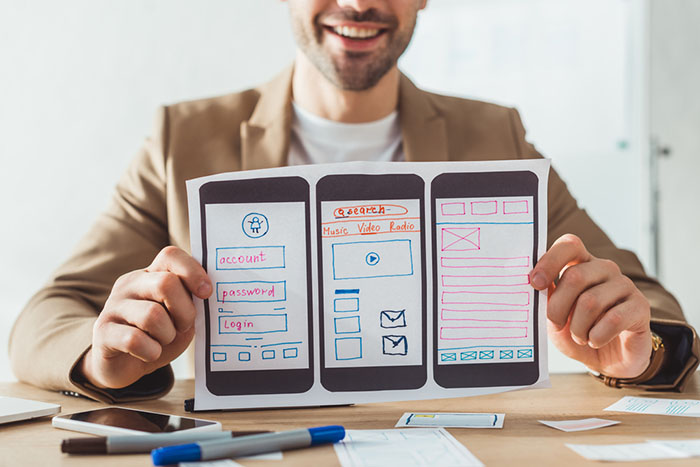Accessible Mobile Design is Good Design for Everyone

In recent years, mobile devices have come to consume our lives. We are able to manage our day-to-day with a few taps on a cell phone screen, keep track of work notes on our tablets, and bring e-readers to catch up on books during our travels. With this rise in dependence on portable technology comes the need for accessible design.
By emphasizing accessibility in your mobile user interface (UI), the reach of your website or app goes so much further. According to the Centers for Disease Control and Prevention, 61 million adults in the United States are currently living with a disability. Accessible features won’t only gain you these consumers, but countless others who are drawn to convenience and comfortability. Here are some of the ways that accessible mobile design can be beneficial for any person, anywhere, anytime.
According to the Centers for Disease Control and Prevention, 61 million adults in the United States are currently living with a disability. Accessible features won’t only gain you these consumers, but countless others who are drawn to convenience and comfortability.
Simple Design
Simplicity is a universal design imperative. No one wants to try to navigate a cluttered webpage with too many visual stimuli. It can be especially challenging for those with visual processing disorders. Visitors will likely stick around for longer if they don’t feel bogged down with graphics and copy right on your homepage. Not only does simple design make your website more accessible in general, but it is easier to convert it from desktop to mobile, and it will be optimized to load faster. This will translate to lower bounce rates, costs, and bandwidth usage. You just have to deliberately choose design elements that say what you need them to say about your brand.
Make sure that your website or app fits the guidelines of the platform you are using. These are put in place with the intent to let you create a unique product that embraces functionality and usability. One element that is suggested is to clearly mark your navigation panel by separating the actions from the text. You can do this by changing the style of the text, perhaps by setting it to bold or underlining it. Buttons should also be separated from the content on your webpage. These adjustments will assist those who benefit from layout consistency.
iOS and Android both offer shortcut configurations in order to accommodate those with physical motor limitations. These are available for button sizes and other touchable triggers, frequently used words and phrases, and the time it takes between presses on the screen. The point of this is so that people don’t have to deal with restrictive navigational behavior. Your smartphone also provides time-saving keyboard shortcuts that you can set yourself by going into Settings. With its autocorrect-like technology, keyboard shortcuts make it easier to send out messages with phrases that you commonly use.
Customizable Experience
Keep in mind that not every user has the same needs or devices. By designing a customizable mobile UI, people can use the options menu to fit those personal needs. For example, users should be able to zoom in up to 200% without the page quality reducing. This is extremely helpful for those with visual impairments. Another way to promote accessible mobile design is through hands-free opportunities. If you have an iPhone, you can take advantage of Siri, the voice assistant that, once programmed, will respond to you from across the room or in the car. The option to change Siri’s voice lets you be navigated by someone you feel comfortable with.
Your videos can, and should, be enhanced with transcriptions or captions. In a study conducted by Oregon State University Ecampus’s Research Unit, it was discovered that 71% of students without hearing difficulties found captions to be useful. Now, imagine what the statistics look like for the greater population that does have hearing difficulties, or even for those who don’t speak the language that your video is in. Captions allow for flexible viewing in environments that are sound-sensitive, such as the library, and provide cognitive reinforcement so that you can absorb information better. More people will be able to effectively consume your content.

Dark mode is another addition to look into. While the science around it is not quite there, many people swear by it being better for low-light settings. This means that you use your device at night or in the movie theater without bothering those around you. Dark mode could also potentially reduce eye strain in those conditions, with some experts claiming that it can help people with visual impairments or light sensitivity. Although there is no hard evidence for the benefits of dark mode, having the option available would be great for those who do prefer their display settings to have minimal color contrast.
Easy to Read and Understand
A primary pillar for accessible mobile design is that you want people to actually be able to read your text. Organize your information so that it is easy to distinguish between headings, subheadings, and body text. You can do this by contrasting the sizing, bolding words, or changing the font. Your copy should be made up of legible, readable fonts that are credited with helping the eye travel across lines of text. Don’t confuse your website visitors with curly cursive. If you can’t casually read it, neither can they. Focus, too, on providing content that is clear by using simple, short sentences where you can. SEO standards recommend using 20 words or less per sentence.
Colors play a big role in data visualization. Adjust the shades of the colors that you are using without losing what makes your design special. While you, unfortunately, won’t be able to accommodate everyone, you should consider which color schemes make the user experience most difficult. You can accomplish this by using contrasting colors, or even adding textures or patterns, in order to make elements stand out. As stated above, you should build a customizable user experience so that consumers are able to change the look based on what conveniences them most.
Using icons that are commonly recognizable is important to user comprehension. They will help people with navigation and doing tasks. An example of this is that, without it even being labeled, if you were to see an icon of a trash can, you would automatically know that it means “delete.” Universal icons like this will be especially advantageous for users that don’t speak your language because, as humans, we all attach meanings to pictures. You should feel free to be creative, but within limits, because certain UI components exist because they have worked for several years.
Before your mobile UI design goes live, you need to thoroughly test it to check whether your accessibility tools are properly implemented. Recognize that if one-fifth of the whole world can’t get behind your product, you are losing out. If your website is in need of creating accessible mobile design fit for any device, let us help you get started.
Posted in: Austin Web Design, Mobile Web Design, Responsive Web Design, WWW Learning Center
Comments are closed.
Latest & Greatest
- Web Design Approaches to Login Page Design
- Unlocking the Power of User-Generated Content
- Beyond Pretty Pictures: Why Solid Web Design Matters (More Than You May Think)
- Getting Creative with Your 404 Not Found Page Design
- Web Design Solutions: Which Option Is Right For You?
- Maximize Your Site Redesign Budget: What Texas Web Developers Need From You for a Cost-Effective Collaboration
- Responsive Web Design in Austin: Why It Matters For Your Local Business
